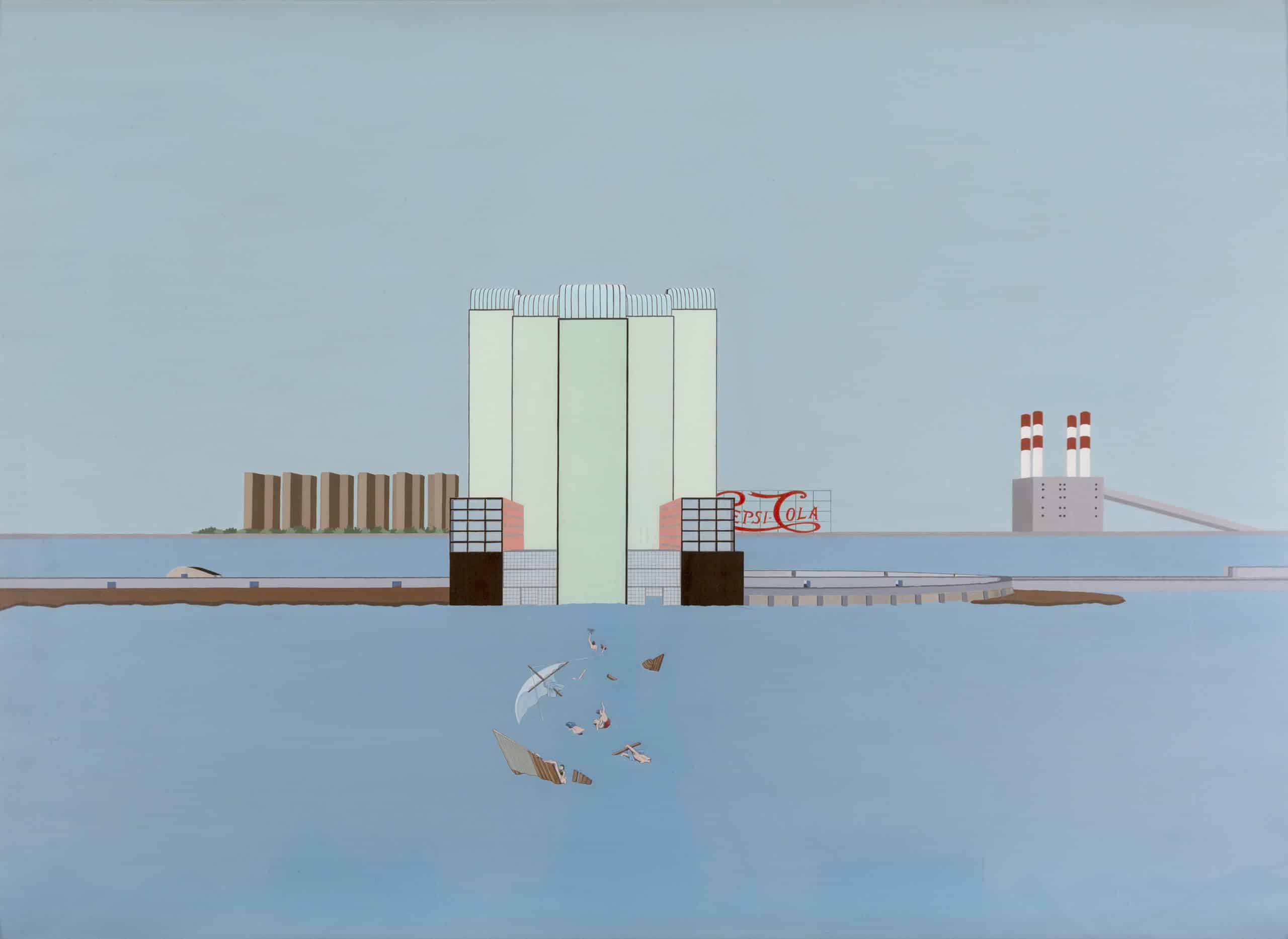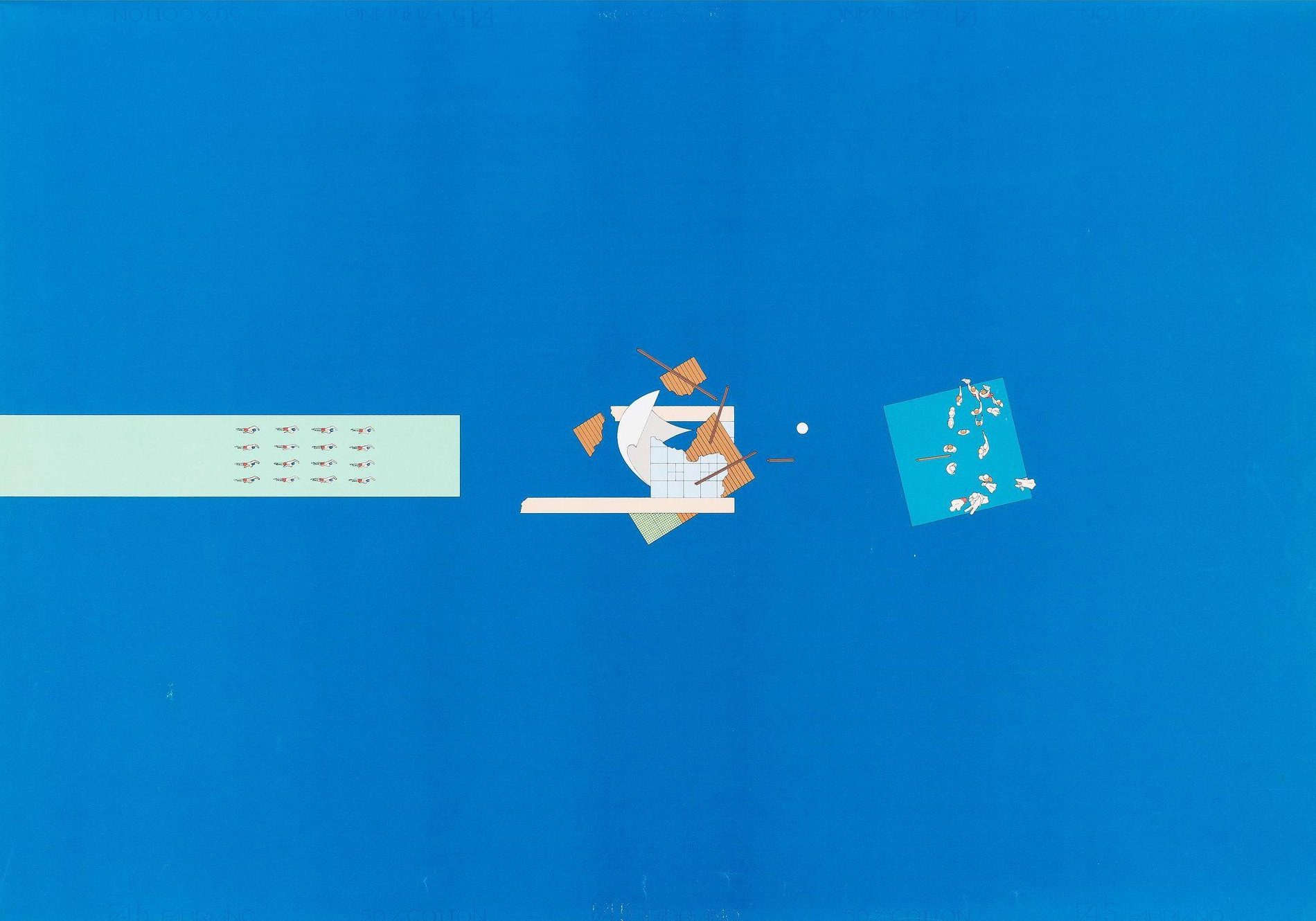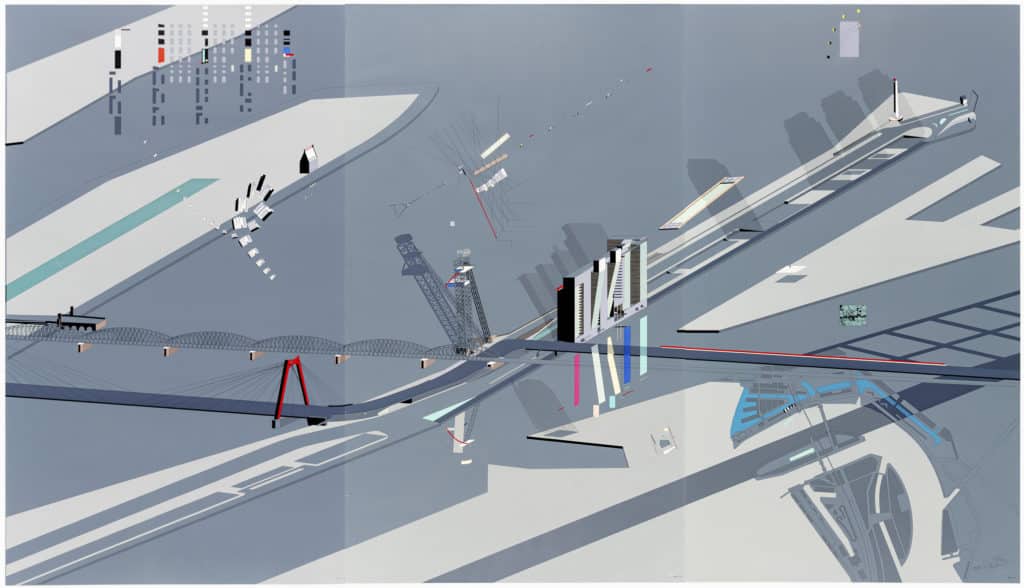Madelon Vriesendorp
– Niall Hobhouse and Madelon Vriesdendorp

Niall Hobhouse: There is a plan to try to talk to as many people as were involved and get them to talk about their particular roles and how the ideas and drawings actually dance, how you can’t really separate them.
Madelon Vreisendrop: No you can’t separate the drawings, they won’t exist outside the ideas.
NH: We wanted to use the occasion of this material that came from Luce van Rooy, to do a kind of archaeology of how the drawings were made…
MV: I am always protesting against all this separation of tasks in an office because now – it is also a financial thing – because the family of Charlotte Perriand wants everything to be hers, that she made this. But how do you do that? Even if you don’t know, you know that in an office people they talk to each other. Already you are drawing differently, or thinking differently in the presence of somebody.
Welfare Palace Hotel, Sunken Medusa Raft, 1975–76 and The Swimming Pool or Medusa Raft, c. 1978 we did much later than Delirious New York, so they are not in the book. There is a funny story about the pool. There was a publisher in Holland who wanted us to do his pool. He had a designer and he said, he will help you with the pool. The designer came to my house and just did a rectangle, which was like a chocolate box. And I said, ‘That is too boring. You can’t just make people do a rectangle and have the swimming pool.’ He also had some Constructivist water; it was all quite ugly. So I said, ‘No, I am doing something else.’ I made a big wave, and the funny paper from the inside of envelopes, I made that the water. Then I made a tiny swimming pool that you could put anywhere – in the wave, or on the wave. Because for forty years it is crossing the ocean. So that is the story of that pool, but it never materialised.
This was the swimming pool arriving in New York and this was a Raft of the Medusa – part of it was a dance floor and it came from the building here. I made the raft into a wreck. But this is completely stupid, this is as if the wind is still blowing. It is unrealistic. These half bodies. The destroyed raft. A lot of bodies are half eaten, they started to eat each other, that is the story of Gericault’s Raft of the Medusa. They are quite near being saved, but are still eating each other. They were headed to the New World.

The swimming pool in the silkscreen is propelled by the swimmers. The irony is that they must swim away from where they actually want to go, and they have to swim toward where they wanted to escape. To propel the swimming pool forward, they had to swim backward.
For both, drawing didn’t necessarily enter into the process. I didn’t draw first. Rem made the drawing and I always did all the people and all the strange stuff, the men swimming. So very often it is a combination. I think Luce was given the painting and the silkscreen. We used to give away things all the time. We sold a lot of stuff to the Gilman Paper Company. the Hotel Sphinx is there, for example.
At one point I drew the Welfare Palace from the other side. I did the whole of Manhattan, the clouds – so that is very much my painting. I feel much more a sense of ownership over this painting, than I do of the one just acquired.

This is the Boompjes Towers. A brilliant guy in the office, Stefano de Martino, he did this whole triptych. Rem told him what to do – that we wanted to see the whole building from different sides. Rem was directing, but Stefano was also unbelievable. I taught him how to do the rubbing with coloured pencils and to rub it instead of draw and immediately he could do it ten times better than I. He is one of these people, you just show him once… He could understand what you meant before you even finished a sentence — an incredibly talented artist.
On the upper left is the White House in Rotterdam. This bridge was going to be taken down and Rem made a construction to stand it up and make a beautiful restaurant at the top. They never could get the money to do it, so they took the bridge away, which was really sad. It was a reference to Leonidov – it was his Leonidov tower and the bridge was a perfect, beautiful construction. It had a lift going up sideways – that is what makes it look Tatlin-ish. It is structural, programmatic and fun. Here is another swimming pool, which came to Rotterdam after its long journey from New York. It is completely random. You really have to ask Rem.
Stefano drew the whole thing up; Rem conducted it. And maybe he made some of the drawing as well, we don’t know. I think it went straight from the drawing to the computer, and then it was transformed by this famous silkscreener, Bernard Ruygrok. He was the best silkscreener at the time. He was working so hard he suddenly developed water around his heart and his son took over. But at that time, everybody went to him, all the artists. So precise.
I will tell you a funny story about the influence of Dali. Rem went to Russia and it was already getting cold. There was a girl in the group of architects that went and she had no warm clothes. Rem, being a gentleman, gave her his coat and his warm gloves. Then he became incredibly ill when he returned. He was in a delirious state and then he read My Secret Life by Dali. It is also, of course, the type of paranoiac-critical method. He was so delirious, it completely opened a whole new world for him. Intelligent.
But nobody recognises Dali’s unbelievable intelligence and humour — he was such a joker. That is the funny thing now, I think that the things that don’t have humour in them don’t reach the real world. Humour is such an important part… I mean, every big thinker – Einstein, for example – they were all humorous people. With a sense of humour, I think you can see a greater perspective of the whole and there is a reach to real life. Humour and irony are integral to painting; there is a lot of humour in my work and that is of course what people don’t take seriously.
The early drawings were visionary but within them was always the possibility of an architecture, the sense that OMA would eventually build. Looking around Rotterdam, Rem’s building there is almost like Welfare Palace. It is really a culmination of all the things he has ever done.
In Response
From Madelon Vriesendorp to Niall Hobhouse, to mark the beginning of 2019: ‘Zoe coloured the Roosevelt scheme, I never use sand or mustard colour, the difference between Greek and Dutch colouring . When I went to Greece I suddenly realised, ‘Ah! That’s where Zoé’s colours come from! Well, ‘never’? Let’s say hardly ever, especially when I have to paint mustard and sand!’
In the interest of a corrective history and multiple stories told through narrative, we thought it best to publish Luce van Rooy’s response on 21 November 2018: A close reading of your interview with Madelon Vriesendorp made me remember clearly the time just before the start of the gallery, how I scraped together the money necessary to buy the painting from Rem.
